Mortuary Temple of Amenhotep III at Luxor (Kom el-Hettan)
Dynasty XVIII
25.721350, 32.609050
Christopher A. Reyes
PHARAOH AMENHOTEP III
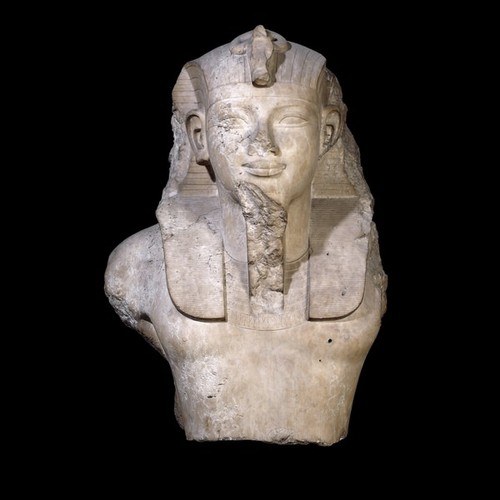
Amenhotep III, son of Tuthmosis IV, was the ninth king of the 18th dynasty of Egypt. He was known as the Pharaoh who brought “prosperity and peace.” He bought upon political stability and devoted his time to the arts in Egypt. Under his reign, he’s constructed many of the most phenomenal structures of ancient Egypt and with help of his military, he was able to extend and strengthen their borders. He completely transformed the landscape of the Nile River. When Amenhotep III was twelve years old, he married Tiye and came to the throne. Once Amenhotep III was older and able to make decisions, he really succeeded in having high approval ratings. He was coined the term “Master of Diplomacy,” due to his “debt through lavish gifts of gold so that they would be inclined to bend to his wishes…” According to researchers, Amenhotep III was considered probably the richest man in the world. During the imperial age, gold flowed into Egypt more than out. Foreign rulers look towards Amenhotep III for gold. They pleaded for it to help change the landscape in their own country.
In 1353 BCE, Pharaoh Amenhotep III died from health complications. His ruling lasted about 40 years alongside his wife, Queen Tiye. He established many great relations with nations around. It was said that they wrote letters once he passed away stating that they will continue to bond with Egypt even though Amenhotep III is gone. His son, Amenhotep IV, succeeded his father and continued follow his father’s steps until he made some changes during his fifth year. Egypt fell under the reign of Amenhotep IV. After his passing, Horemheb took over and tried his best to restore Egypt to the days when Amenhotep III ruled, however it didn’t manage to reach those heights again. Amenhotep III went down to be the “luxurious pharaoh, diplomat, hunter, warrior, and great architect of Egyptian monuments.
AMENHOTEP III'S MORTUARY TEMPLE
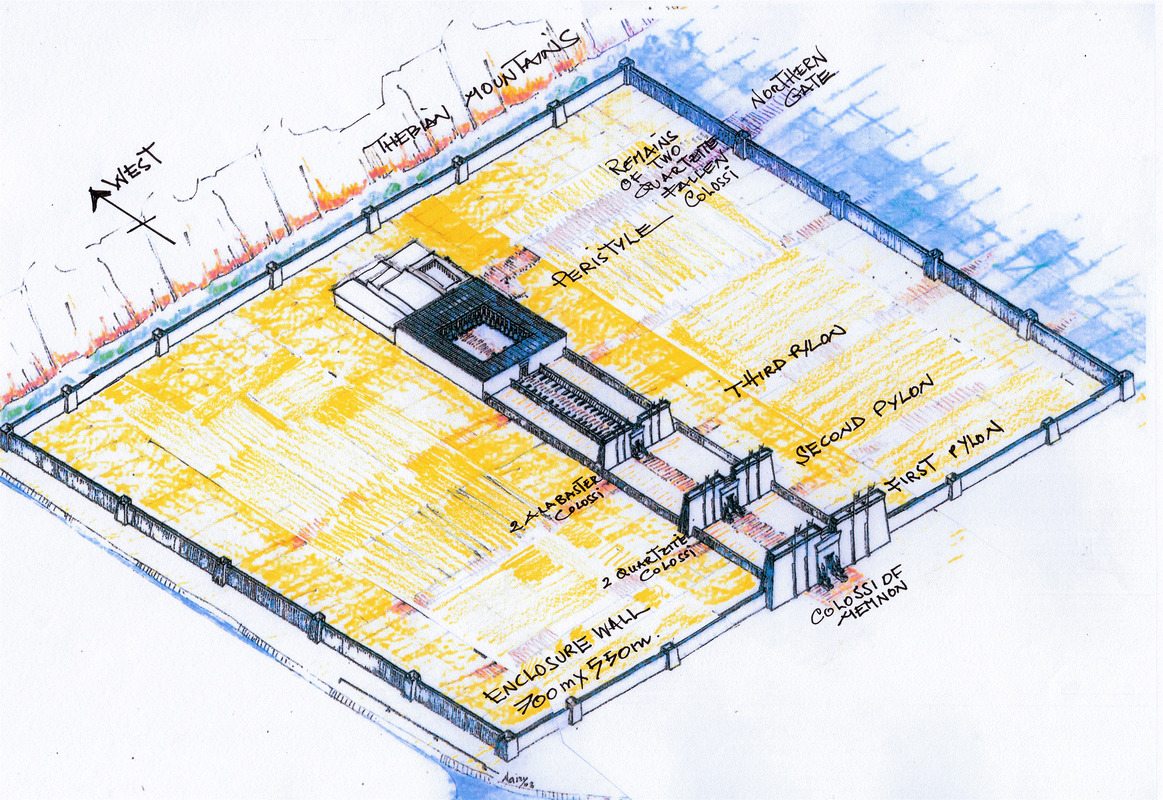
Pharaoh Amenhotep III’s legacy was recognized in a mortuary temple made for rituals and infinite offerings to honor the Pharaoh after his passing. As many know, Amenhotep III did not build small structures. His architectures were jaw-dropping and mesmerizing. Of course, his temple had to relate to something he would’ve done. The mortuary temple was constructed near his tomb and was considered “the grandest of all mortuary temple complexes built in Egypt.” The mortuary temple began construction in the city of Luxor along the Nile River. It included “three massive mud-brick pylons, or gats, aligned on a single axis, and a long connecting corridor leading to an immense, open solar courtyard, a roofed hall, a sanctuary, and sacred alter.” The whole structure contained hundreds of statues, sphinxes, and slabs that contained Amenhotep III’s legacy. At the entrance of the mortuary temple, the Colossi of Memnon stands tall and a long corridor with the “gates”, which leads to the Sun court. The Sun court was divided into two different halves, North and South. Both sides contained statues of Pharaoh Amenhotep III and other gods. The temple itself is gigantic. It measured 328 feet wide by 1,968 feet in length.
After a major earthquake, the Mortuary Temple of Amenhotep III was destroyed. It was dated to happen around 1200 BC. Roman authorities decided to come in and reconstruct some of it, but there was another earthquake in 27 BC that ruined it again. Currently, the only thing that stands are the Colossi of Memnon. It depicts Amenhotep III sitting down with his hands on his knees, gazing across the Nile. These statues were made from quartzite sandstone and transported overland to Luxor. They reach 60 feet in height and it weighs almost 720 tons. The statues are almost unrecognizable now, but they are remembered as the guardians of the Mortuary Temple of Amenhotep III. This grand temple was envied by other pharaohs. The Temple of Karanak was also being built during this time and it was smaller. No one was able to compete.
EXCAVATING THE TEMPLE

Having been built too close to the Nile River, The Mortuary Temple of Amenhotep III was severely damaged. Through centuries, the water from the Nile repeatedly inundated the structure, destroying the architecture and precious statues. The earthquake, as mentioned before, obviously continued to damage the temple. Also, pieces of the structure were stolen and used for other temples. To top it all off, the structure has been engulfed in fires, vandalized, and even, robbed.
In 1998, Armenian archaeologist, Hourig Sourouzian, convinced the World Monuments Fund to classify the Mortuary Temple of Amenhotep III to be one of the world’s “100 Most Endangered Sites.” Sourouzian started the journey to rescue the long-neglected site and the statues inside. She actively expressed that “they didn’t deserve this treatment.” Many Egyptologists declared that this site was ultimately dead. The only two things that remained at the temple were the Colossi of Memnon. Sourouzian was quite interested in this structure and after she witnessed the destruction of the fire in 1996, she made it her duty to do something about it. “It was terrible and depressing, and we swore to take action.” French, Swiss, Spanish, Japanese, and German researchers were called to help with the challenge of rising the temple of the ashes. Sourouzian orchestrated the researchers and over 400 local workers to get to work. This project was witnessed as “one of the most ambitious projects Egypt has seen in decades…” What was once a phenomenal structure was going to make the biggest comeback. Amenhotep III called the complex “a fortress of eternity out of good white sandstone – worked with gold throughout. Its floors were purified with silver, all of its doorways were of electrum.”
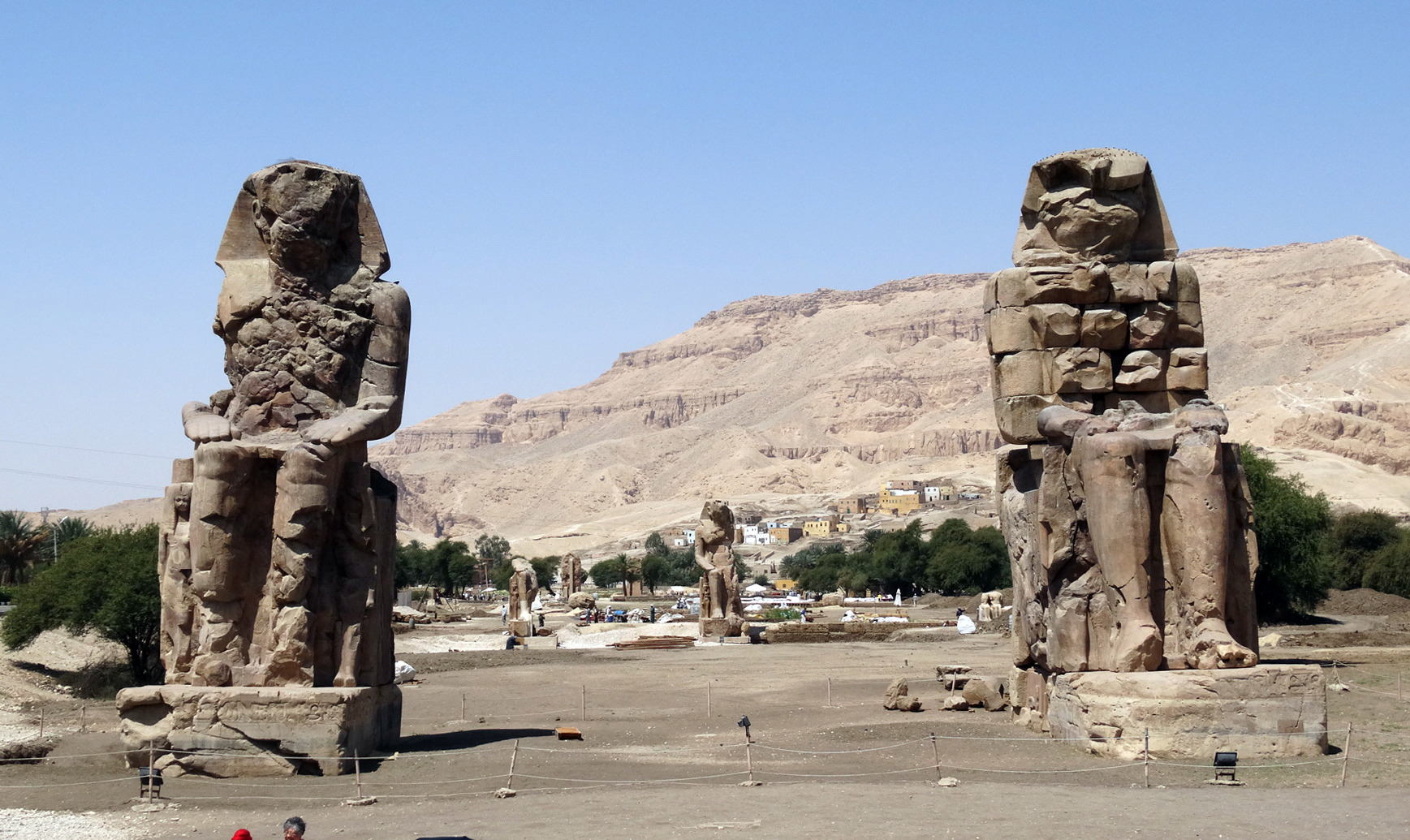
Treasure lied beneath all that dirt and sand. It took a plethora of years to restore and it’s not even over. It is predicted to take two decades or more to rise the temple again. Before it was wrecked, the structure was described as “once brightly painted in blues, greens, yellows, and whites, the 50-foot colossi in front of the massive first gate, or pylon, loomed over the Nile Valley’s flat farmland, facing the brown river that then flowed just a few hundred yards away.” On the morning of excavation day, Sourouzian and her team flow out of their van and into a storeroom where the artifacts and pieces found by her. She was described as “Isis reassembling Osiris…goddess who recovers dismembered pieces of her lover and restores him to life.”
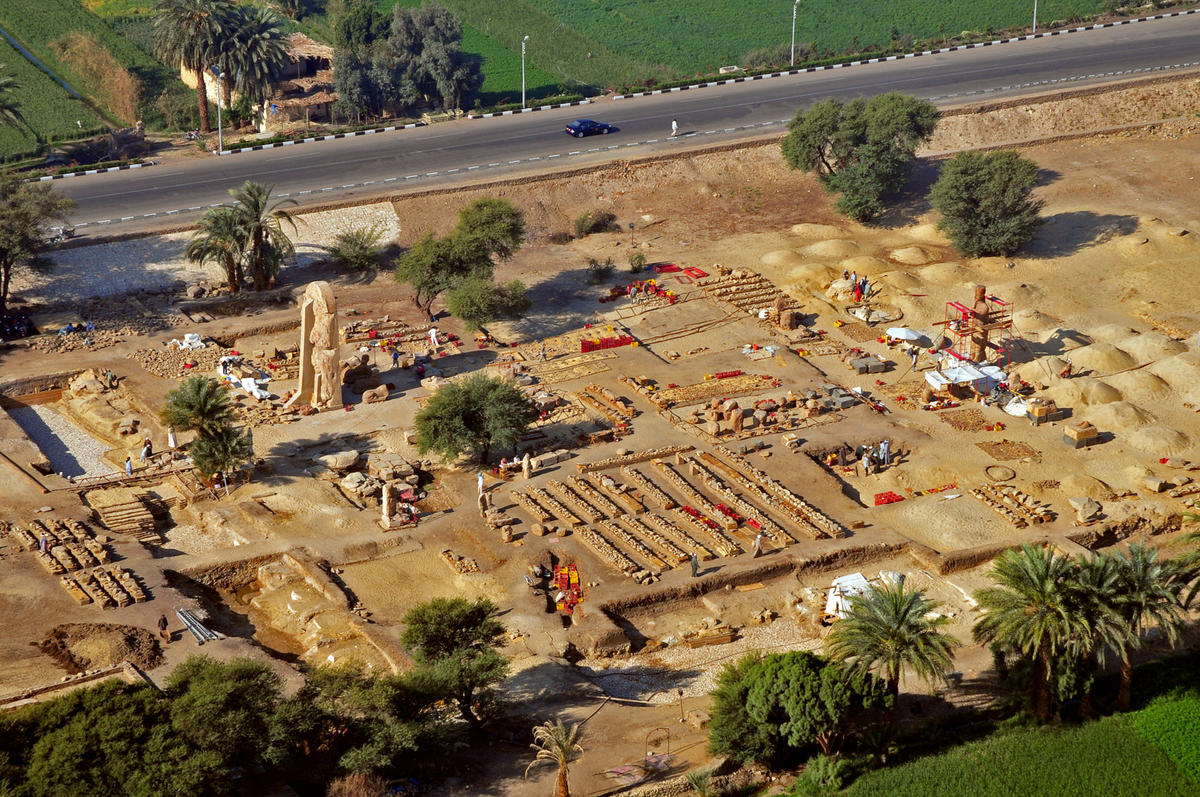
Over the years, the site has risen! Monuments across the temple can now be seen from the street. The Colossi of Memnon at the First Pylon has been used to investigate and survey different things like geology, archaeo-seismology, and polychromy, etc. Many of the fragments found around the statues have been placed back to its original place. The Second Pylon was recently raised. The colossi stand 100m to the West of the Memnon Colossi. The risen using ancient traditional methods. At the Third Pylon, two more colossi were found 3 meters below ground and are still being lifted out. Water caused major damage to the Peristyle Court. Conservation for this area has been carried out for many years. Today, most of the statues, stelae and walls are reassembled and the architecture was cleaned. IN the Peristyle Court, the Northern Stela was found broken into small pieces of quartzite all over the court. It was re-erected in 2011 and by 2012 it was fully completed and stood symmetrically to the southern stela, which had a similar height to the northern one. The Southern Stela was lifted in the 1950s and today, it is complete with some findings done by Sourouzian’s team. The colossal statues of the king standing in quartzite were reassembled from all the fragments found across the temple. Currently, only two have been risen and the other four are just the feet. The head of one statue was reconstructed from over 100 scattered pieces and was placed in the Luxor Museum of Art. Lastly, many other statues of the king and of animals were erected and were put back on display. Most of the pieces of these statues were found in rubble and pits due to the natural disasters the temple has gone through. At the North Gate, a pair of royal colossi in quartzite were recently lifted. These were victims of the earthquake and it was confirmed as an emergency to lift these statues up immediately. Thankfully, a rare piece from a fallen sandstone block from the walls of the peristyle was found and restored. “They bear texts with the name and that ‘Amenhotep III made a temple of millions of years to his father Amon-Re’.” The site is destined to be completed. However, money is a major issue that archaeologists and Egyptologists run into because it takes millions to complete the project. However, they do not plan to stop and will continue to bring back the Mortuary Temple of Amenhotep III.
CONCLUSION
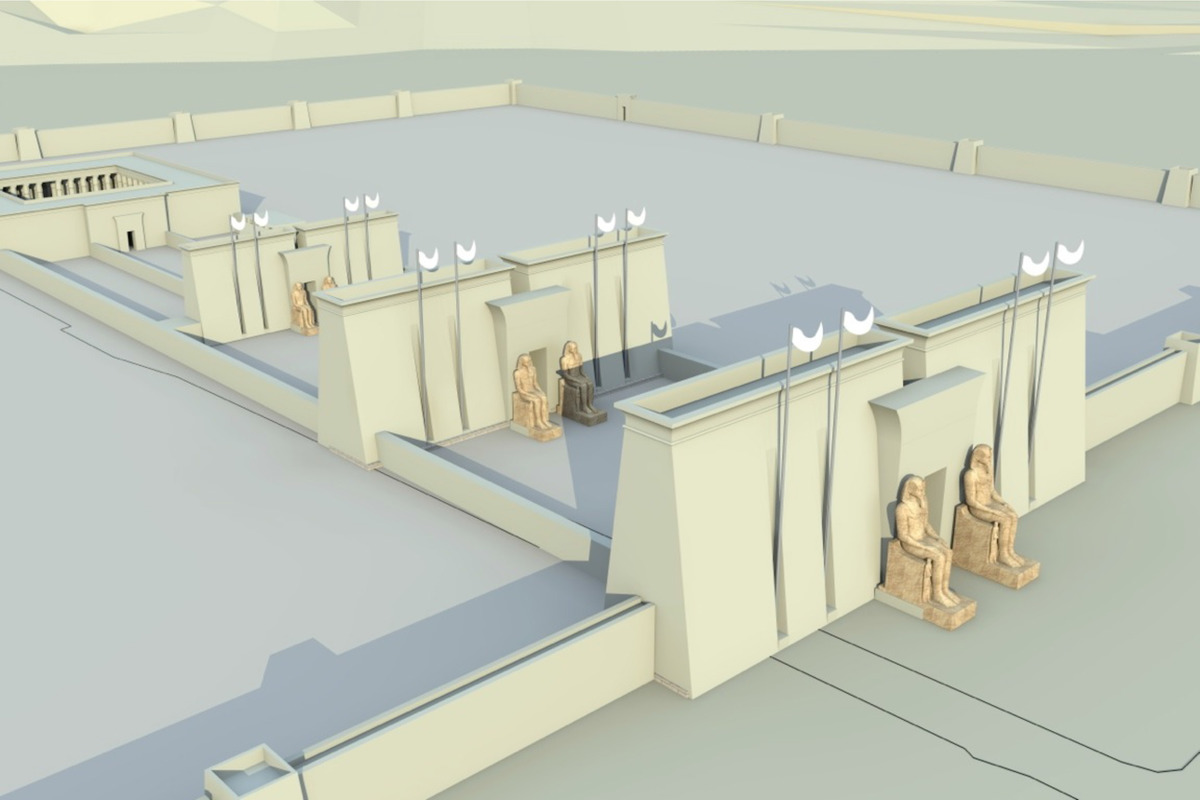
The Mortuary Temple of Amenhotep III will remain to be the grandest temple in Thebes. As it continues to grow, archaeologists and Egyptologists are learning more and more about King Amenhotep III and his visions for his temple. Not only are the bigger artifacts being found, but smaller artifacts like pottery are being examined by other researchers. King Amenhotep III had a mission and it is saddening that it was completed destroyed with natural disasters and looters. He was a king that was praised by many and people should be glad that Sourouzian and the many other archaeologists understand this and want to bring the temple back. In a few years, it will be incredibly to travel to Luxor and appreciate Amenhotep III’s vision of the temple, the work of the Egyptians back then that made it happen and the current archaeologists, who brought it back to life.
REFERENCES
Written:
Bunson, M. (1991). The encyclopedia of ancient Egypt (p. 97). New York: Facts on File Publications.
Archaeoseismological studies at the temple of Amenhotep III,Luxor, Egypt, Arkadi Karakhanyan et al, The Geological Society of America Special Paper 471, 2010
R. F. Heizer; F. Stross; T. R. Hester; A. Albee; I. Perlman; F. Asaro; H. Bowman (1973-12-21). "The Colossi of Memnon Revisited". 182 (4118). Science magazine: 1219–1225. doi:10.1126/science.182.4118.1219. PMID 17811309. Retrieved 2011-08-22
"The Seventy Wonders of the Ancient World", edited by Chris Scarre (1999) Thames & Hudson, London
Mark, Joshua J. "Amenhotep III." Ancient History Encyclopedia. Ancient History Encyclopedia, 15 Jul 2011. Web. 13 Nov 2018.
Lawler, Andrew. “Unearthing Egypt's Greatest Temple.” Smithsonian.com, Smithsonian Institution, 1 Nov. 2007, Web. 13 Nov 2018.
Stiftung, Gerda Henkel. “Conservation Work at the Temple of Amenhotep III at Thebes, By The Colossi of Memnon and Amenhotep III Temple Conservation Project.” L.I.S.A. SCIENCE PORTAL GERDA HENKEL FOUNDATION, 22 Dec. 2016. Web. 13 Nov 2018
Sourouzian, Hourig, Rainer Stadelmann, Myriam Seco Alvarez, Laurent Bavay, Helmut Becker, Philippe Bromblet, Mourad El-Amouri, Samia Emara, Jens Linke, Frédéric Pernel, Franz Schubert, Mary Schubert, and Fritz Wenzel 2004. The temple of Amenhotep III at Thebes: excavation and conservation at Kom el-Hettân. Third report on the fifth season in 2002/2003. Mitteilungen des Deutschen Archäologischen Instituts, Abteilung Kairo 60, 171-236.
Kozloff and Bryan, Egypt’s Dazzling Sun: Amenhotep III and his World. 1992.